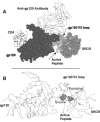Antiviral activities in human saliva
- PMID: 21441478
- PMCID: PMC3144043
- DOI: 10.1177/0022034511399282
Antiviral activities in human saliva
Abstract
In this review, the authors survey the large number of antibacterial and antiviral proteins present in human saliva. Of interest, most of these antibacterial proteins display antiviral activity, typically against specific viral pathogens. The review focuses on one protein that interacts with both bacteria and viruses-gp340, originally referred to as salivary agglutinin. In the oral cavity, soluble gp340 binds to and aggregates a variety of bacteria, and this is thought to increase bacterial clearance from the mouth. However, when bound to the tooth surface, gp340 promotes bacterial adherence. In the oral cavity, most gp340 is found soluble in saliva and can function as a specific inhibitor of infectivity of HIV-1 and influenza A. In contrast, in the female reproductive track, most gp340 is bound to the cell surface, where it can promote HIV-1 infection.
Figures



References
-
- Archibald DW, Cole GA. (1990). In vitro inhibition of HIV-1 infectivity by human salivas. AIDS Res Hum Retroviruses 6:1425-1432 - PubMed
-
- Bergey EJ, Cho MI, Hammarskjold ML, Rekosh D, Levine MJ, Blumberg BM, et al. (1993a). Aggregation of human immunodeficiency virus type 1 by human salivary secretions. Crit Rev Oral Biol Med 4:467-474 - PubMed
-
- Bergey EJ, Gu M, Collins AR, Bradway SD, Levine MJ. (1993b). Modulation of herpes simplex virus type 1 replication by human salivary secretions. Oral Microbiol Immunol 8:89-93 - PubMed
-
- Bikker FJ, Ligtenberg AJ, End C, Renner M, Blaich S, Lyer S, et al. (2004). Bacteria binding by DMBT1/SAG/gp-340 is confined to the VEVLXXXXW motif in its scavenger receptor cysteine-rich domains. J Biol Chem 279:47699-47703 - PubMed
Publication types
MeSH terms
Substances
Grants and funding
LinkOut - more resources
Full Text Sources
Other Literature Sources
Medical

